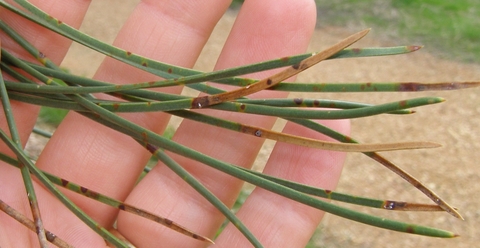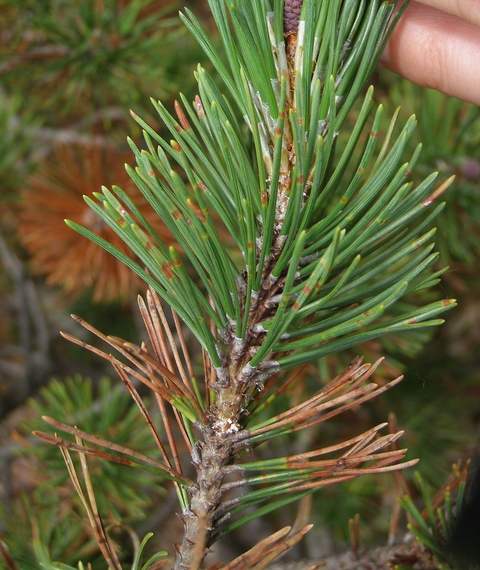Quick facts
-
Dothistroma needle blight of pine trees causes needles to turn brown and fall off.
-
Severe infection for several years in a row can cause tree death.
-
Manage this disease by maintaining good air circulation, mulching and preventing sprinklers from spraying needles.
-
Austrian pine and Ponderosa pine are most likely to be damaged by this disease.
-
Red pine and Scots pine are mostly resistant.
-
Fungicides can be used to protect trees from Dothistroma needle blight.
How to identify Dothistroma needle blight
Needle symptoms
Reddish-brown spots scattered on green needles. These spots grow into a band, encircling the needle.
Tip of the needle turns brown while the base of the needle remains green. These two sections are separated by a reddish-brown band. The transition from green to dead areas is abrupt.
Eventually, needles turn completely brown and fall off.
Older needles found close to the trunk are more severely affected compared to the younger needles that are found towards the ends of the branches.
Within the spots and bands, you may see tiny bumps pushing through the surface of the needle. These black, pimple-like structures produce fungal spores.
Needles on lower six feet of a tree are most noticeably affected. Needles over 20 feet high are rarely affected.
When do symptoms appear?
New infections often appear in late summer to fall.
Dead needles and spots may be seen at any time during the year on a plant with reoccurring disease.
Lab analysis is often necessary to distinguish Dothistroma needle blight from Brown spot. Submit a sample to the Plant Disease Clinic for testing.
Trees affected by Dothistroma needle blight in Minnesota
Trees most severely damaged
Austrian pine (P. nigra)
Ponderosa pine (P. ponderosa)
Tree less affected
Mugo pine (P. mugo)
Mostly resistant
Red pine (P. resinosa)
Scots pine (P. sylvestris)
How does Dothistroma needle blight survive and spread?
- Dothistroma needle blight is caused by the fungus Dothistroma septosporum (syn. Mycosphaerella pini).
- Dothistroma needle blight is a slow-moving disease that takes over a full year to complete its life cycle. It takes several years of repeated infection to develop into a serious problem within the tree canopy.
- Spores are produced on infected needles throughout the growing season whenever cool, wet weather occurs.
- Spores are spread by wind or rain to needles within the same tree or in neighboring trees.
- Infection occurs if spores land on susceptible needles under favorable weather conditions.
- Second year or older needles are susceptible to infection anytime during the growing season.
- Young needles are resistant until they reach maturity in early to mid summer.
- Several consecutive days of cool (41-77°F), wet weather are needed for successful infection.
- Reddish brown spots or bands appear on needles in the fall.
- Needle spots eventually girdle the pine needle. The needle beyond the band then dies and turns brown leaving the bottom portion of the needle green.
- Tiny black fungal fruiting bodies called stromata appear in the bands or in dead areas of the needles. These fruiting bodies will release spores the following year.
- Infected needles may remain attached to the tree for one or two years depending on the age of the needle at the time of the infection.
- Eventually infected needles turn completely brown and fall off prematurely.
How to manage Dothistroma needle blight
Maintain good air circulation around trees
Do not overcrowd plants. Use the mature size of the tree as a spacing guide when planting.
Remove the bottom most branches from the trunk to help increase circulation around the tree canopy.
Mulch under trees
Remove all weeds under the trees.
Maintain a 3 to 4 inch deep, even layer of wood chip mulch around your tree to prevent weed growth.
Leave at least a 2 inch space between the mulch and the trunk to allow for air movement.
Do not mound the mulch around the trunk of the tree.
Inspect the depth of the mulch layer each year. Add additional mulch only to maintain a 3 to 4 inch depth.
Don’t allow sprinklers to spray needles
If the tree is in a landscape with a sprinkler irrigation system, make sure that water is not spraying the needles.
When setting out sprinklers, direct the water away from needles.
Plant disease tolerant pine trees
In low lying or other areas with cool, moist air, where environmental conditions are favorable to Dothistroma needle blight, plant Scots pine or Red pine trees.
Avoid planting Austrian or Ponderosa pines in areas with a history of Dothistroma needle blight or where environmental conditions favor disease.
Fungicides
If trees have a history of Dothistroma needle blight, copper fungicides can be used to protect new needles from infection.
Fungicides need to be applied:
once just before buds open in the spring (typically in mid-May) to protect previous year’s needles.
once after new needles have grown to their full length (in early to mid summer).
CAUTION: Mention of a pesticide or use of a pesticide label is for educational purposes only. Always follow the pesticide label directions attached to the pesticide container you are using. Remember, the label is the law.
Reviewed in 2024




